Who would’ve thought that watching a Pixar movie would teach you authentic facts about different marine inhabitants.

In this post, I will list the real species of fish from the film Finding Nemo. The famous Nemo, for example, is an actual type of clownfish, and his behavior in the movie is based on real-life traits.
After I figured that out, I went ahead and researched what kind of fishes are Dory, Gill, Deb, and the rest of the main characters.
I will also share with you the names of the scary fish with the light, as well as other secondary characters, such as the buck teeth Kathy and Nemo’s teacher Ray.
So let’s dive in!
24 Popular types of fish from the movie Finding Nemo
I’m assuming some of you are eager to find out what the fish from Finding Nemo is simply out of curiosity.
Others are likely beginner or advanced aquarists who are inspired to start a Nemo-based fish tank with representatives of the species from the movie. For this reason, I made sure to also provide the real-life scientific names of the movie characters.
Moreover, I will give some hints on whether these types of fish can be kept in a home aquarium or not.
This would make your upcoming fish care research easier.
If not – the information here will likely help you solve a crossword clue or two.
Here are the types of fish that the characters from Finding Nemo are based on:
1. “Nemo”, “Marlin”, “Coral” – Ocellaris Clownfish (Amphiprion Ocellaris)
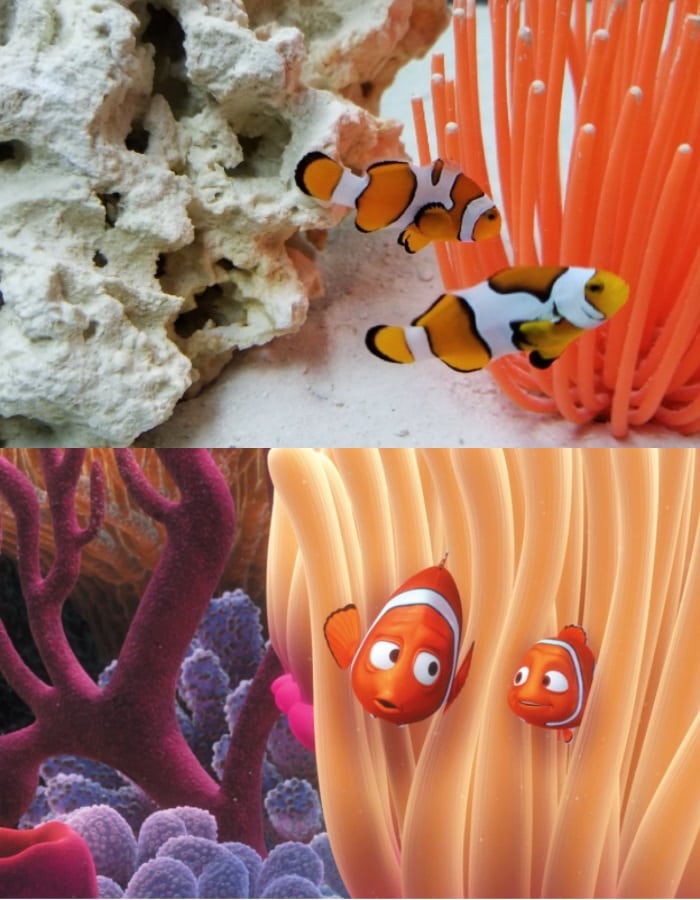
Clownfish by Philipgonzales3
Nemo, as well as his mom and dad – Coral and Marlin – are Ocellaris Clownfish.
These fish have orange bodies, striked by three white stripes with black outlining.
The Ocellaris Clownfish are a popular species within the Amphiprion genus, and are a kind of ray-finned fish.
In fact, this genus includes all known clownfish species in the family Pomacentridae except the Maroon clown.
The Ocellaris Clownfish are quite common in the aquarium hobby. Unlike other types of clownfish that can be territorial and aggressive, the Ocellaris is rather peaceful and easy to take care of.
That’s why many beginner aquarium keepers would try to get one of these saltwater fish, after seeing them in the movie.
Anyway, a few scenes show some key traits of the Clownfish species.
Finding Nemo begins with Marlin and Carol, discussing their new home – a Sea Anemone. Clownfish actually form a simbiotic relationship with some types of anemones.
Author’s note: Sea anemones are close relatives to corals and jellyfish that have stinging polyps which are dangerous to fish. Nevertheless, through a process called acclimation, clownfish can adapt to their host anemone and live in it.
When Marlin asks Nemo to brush onto their anemone’s polyps, he’s encouraging him to acclimate, so that his son doesn’t feel the stings in the future.
These small details in Finding Nemo are among the scenes that can help you learn interesting facts about the fish species the characters are based upon.
2. “Dory” – Blue Hippo or Regal Tang (Paracanthurus hepatus)

Blue Hippo by ibjhb
Dory is a Palette Surgeonfish, which is also known by their more popular names – Blue Hippo Tangs or Regal Tangs.
One of the most popular species of Indo-Pacific surgeonfish for marine aquaria, the Palette Surgeonfish is the only member of the genus Paracanthurus.
The distinctive visual traits of this type of fish are a blue body, yellow tail, and a black “palette” pattern.
Many aquarists keep a Blue Hippo Tang in their saltwater reef tanks but it’s not the easiest of tasks.
These fish are particularly sensitive, need a large aquarium, and are prone to diseases. It’s not unheard of to lose an expensive Blue Hippo Tang to the saltwater parasites that cause Ich.
So if you’re determined to start a Finding Nemo aquarium, you can get Dory to join in.
However, you’ll need some prior experience in keeping saltwater fish and I do not recommend trying it out as a beginner.
3. The fish that eats Nemo’s mom Coral – Barracuda (Sphyraena)

Barracuda by DirtyDan156
The big scary fish that appears at the beginning of the movie and kills Nemo’s mom and her babies is a Barracuda.
Coming from the Sphyraena genus, the barracuda, named cuda for short, is well known for its creepy appearance and fierceness.
This fish is a saltwater carnivore with powerful jaws and a large narrow body.
4. “Tad”, “Bill” – Longnose Butterflyfish (Forcipiger flavissimus)
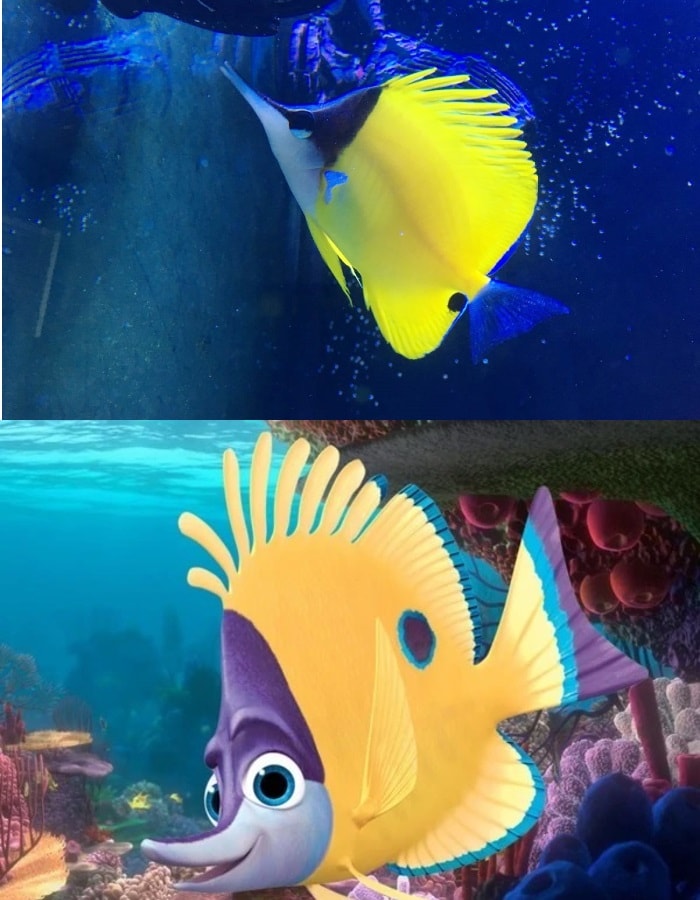
Longnose Butterflyfish by Kershaw
Nemo’s classmate Tad is a yellow and purple Longnose Butterflyfish.
The long, slender snouts of the Longnose Butterflyfish are typical for the species of the Forcipiger genus.
The fish from this genus are widespread throughout the Indo-Pacific region, and the genus’ name, by the way, means “bearing forceps”.
Anyway, in the movie, you can also see Tad’s father – Bill, among other parents.
The non-fish parents you see in these scenes are the seahorse Bob, and the pink flapjack octopus Ted – the father of Pearl.
Tad and his dad Bill aren’t the main characters in Finding Nemo and just appear briefly.
Nevertheless, they sure are attractive fish that can be kept in home saltwater aquariums.
So if you want to keep one of these beautiful fish species, you can research the Longnose Butterflyfish and add them to your new tank.
5. “Mr. Ray” – Spotted Eagle Ray (Aetobatus narinari)
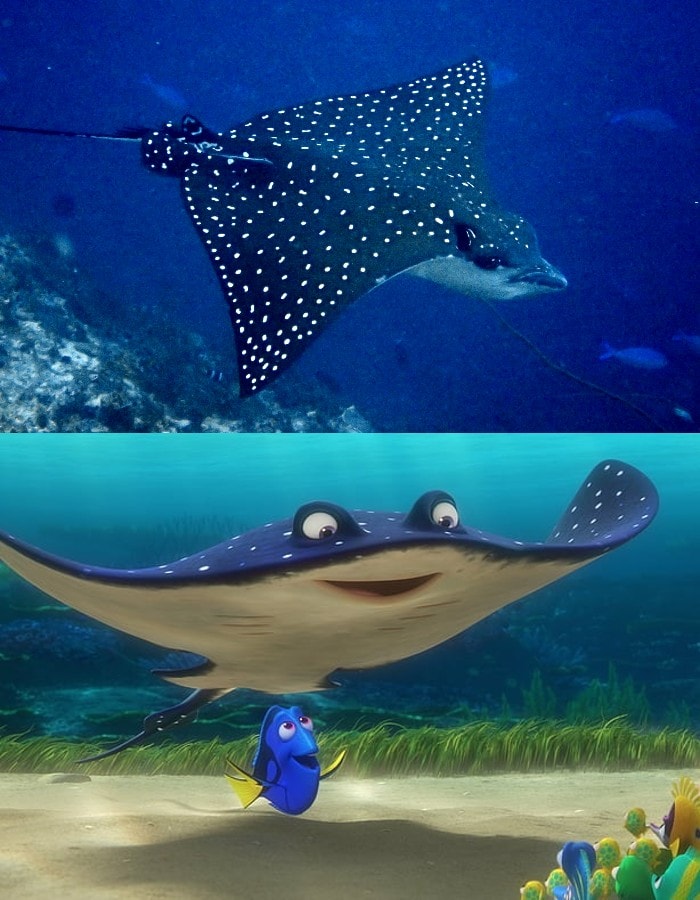
Spotted Eagle Ray by salty_sea_doggg
The likable Mr. Ray from Finding Nemo has many wondering what kind of fish he actually is.
Well, Nemo’s teacher Mr. Ray is what’s known as a Spotted Eagle Ray from the Aetobatus genus distributed throughout tropical and warm temperate waters of the Atlantic, Pacific, and Indian Oceans.
These types of ray fish are characterized by a blue body and white spots.
Their span can reach up to 11 feet or over 3 meters, which makes them the second largest species of Eagle Ray, with the Manta Ray holding the first place.
6. “Mr. Johannsen” – European Flounder (Platichthys flesus)
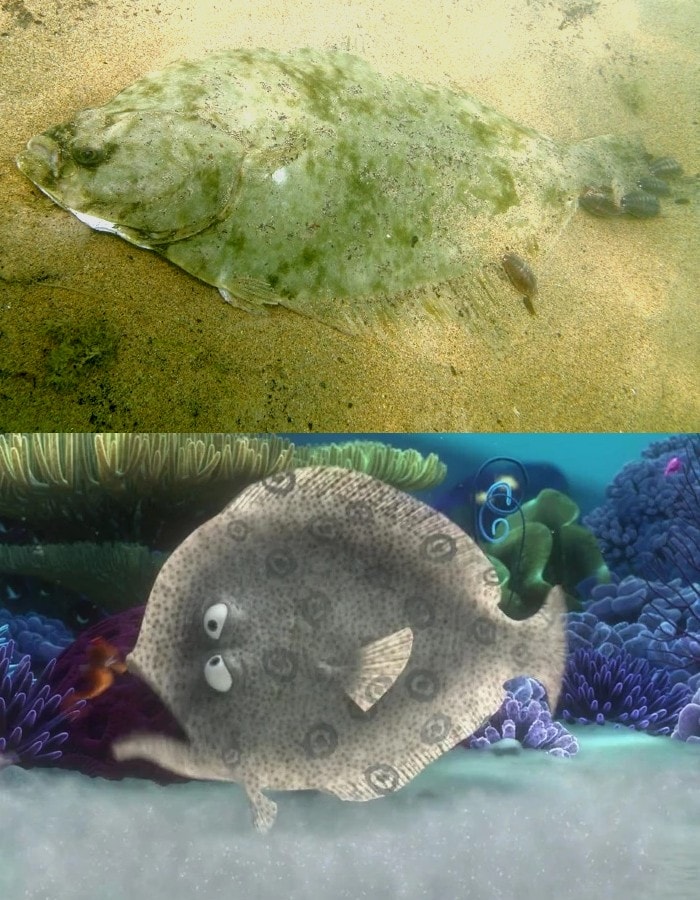
European Flounder by rpillon
Many are curious to find out what type of fish is the flat Mr. Johannsen from Finding Nemo.
He is a Flounder from the Platichthys genus of flatfish native to the North Pacific and North Atlantic oceans.
Moreover, it is curious that a large number of species belonging to this genus look like they’re “right-eyed” because both of their eyes are on the right side of their body.
These peculiar-looking flatfish live on sandy bottoms in the ocean.
Their coloring merges them with their environment and makes them difficult to detect.
7. “Bruce” – Great White Shark (Carcharodon carcharias)
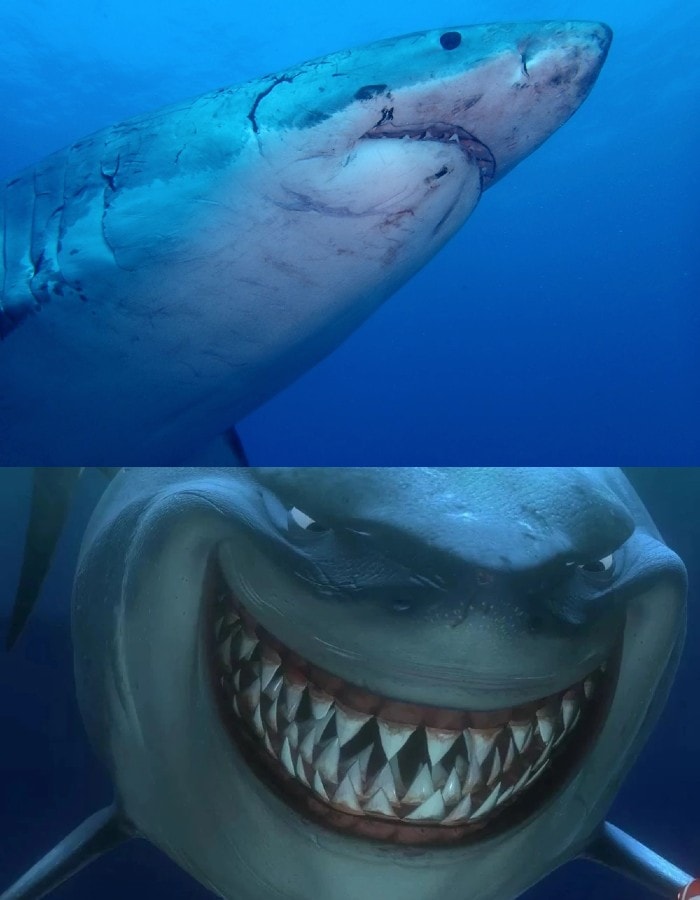
Great White Shark by VanAR
Bruce from Finding Nemo is a predator with big scary teeth, who made a pledge not to eat fish.
As a species in real life, he’s a Great White Shark.
The Great White Shark comes from the Carcharodon genus which includes two other species – Carcharodon caifassii and Carcharodon hubbelli.
Both other species are extinct and the only extant member of the genus is the Great White.
Unfortunately, in reality, these carnivores don’t betray their nature and would happily prey on big and small marine inhabitants.
Looking to add clownfish to your reef aquarium? Check out different varieties here.
8. “Chum” – Shortfin Mako Shark (Isurus oxyrinchus)
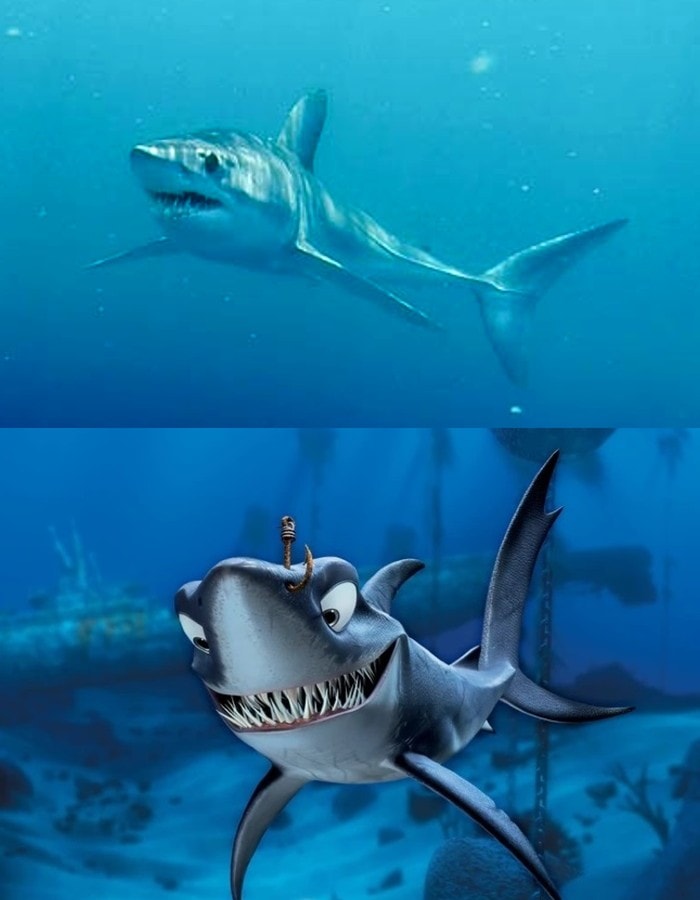
Shortfin Mako Shark by jonp
Bruce’s friend, Chum, is a type of shark known as Shortfin Mako Shark.
The mako sharks are a part of the Isurus genus of mackerel sharks in the family Lamnidae.
These large and ferocious sharks also have many other names such as Blue Pointers or a Bonito Sharks.
9. “Anchor” – Great Hammerhead Shark (Sphyrna mokarran)
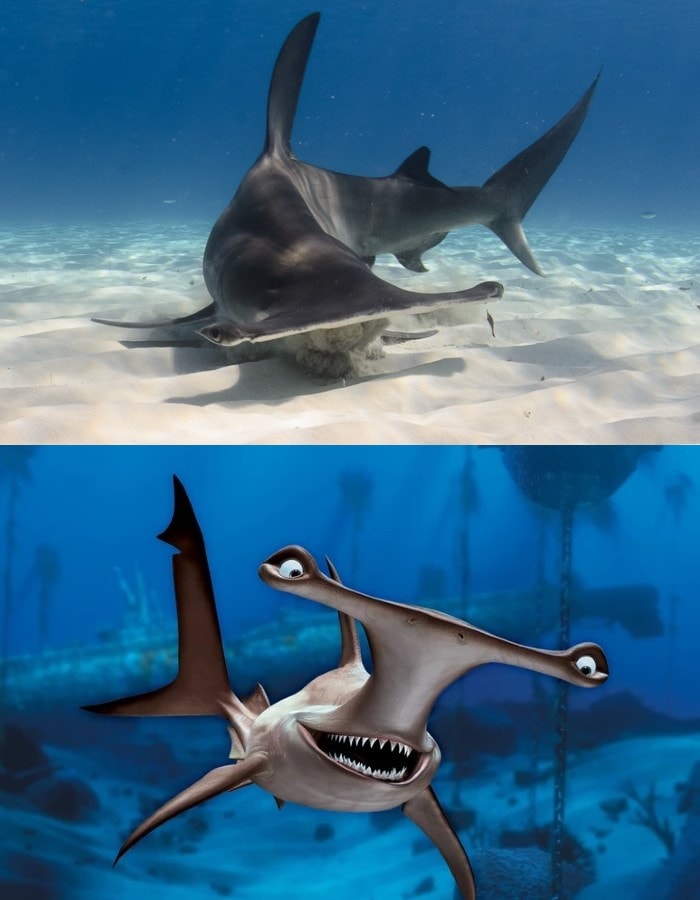
Great Hammerhead Shark by jason folt
Anchor is a Great Hammerhead Shark, who, along with Bruce and Chum, is part of the “Fish are Friends, Not Food” support group.
In real life, the huge population of hammerhead sharks belongs to the Sphyrna genus.
The members of the genus usually inhabit coastal waters rather than the open ocean.
10. “Bubbles” – Yellow Tang (Zebrasoma flavescens)

Yellow Tang by OrionN
The yellow fish that likes bubbles from the aquarium in the dentist’s office in Finding Nemo is a Yellow Tang.
It is a part of the Zebrasoma genus which belongs to the Acanthuridae family of surgeonfishes who live in the tropical seas.
The representatives of this fish species are quite popular in the saltwater aquarium hobby.
Nevertheless, if you’re planning on getting one of these beauties, you should keep in mind that they can get quite aggressive towards their tank mates.
Yellow Tangs may also damage some types of corals if you are to keep them in a reef aquarium.
I recommend doing proper research before getting one to look after.
11. “Deb”, “Flo” – Striped Damselfish (Dascyllus aruanus)
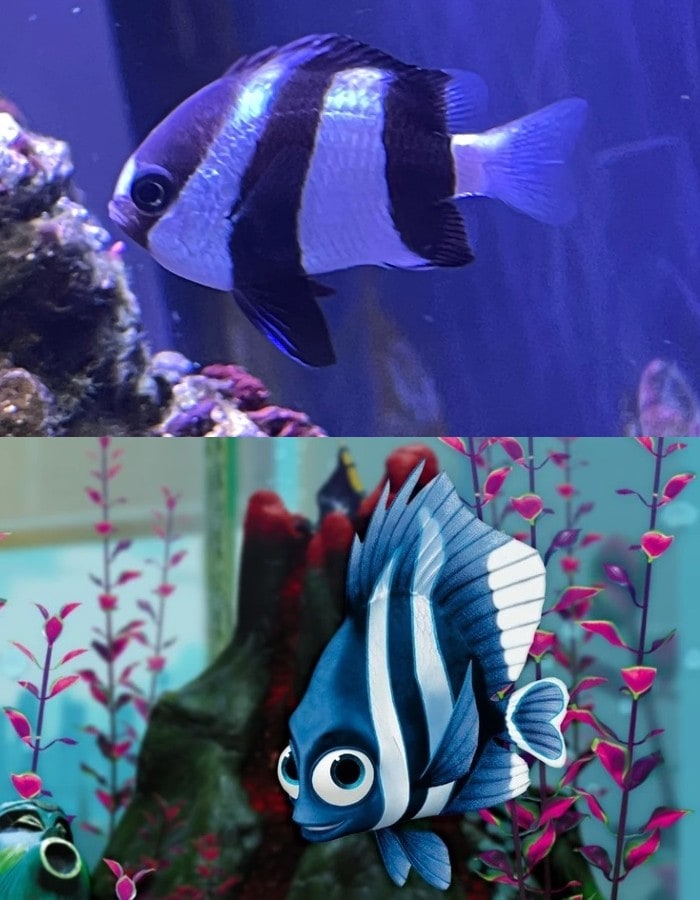
Striped Damselfish by ChloeHatesJoji
Deb and Flo are actually the same movie character.
Deb thinks her reflection in the aquarium glass is her sister Flo.
Anyway, they both are Striped Damselfish, also known as Humbug Damselfish.
The Striped Damselfish are a species of marine fish within the Dascyllus genus that are habitually benefiting from their relationship with corals.
In reality, these beautiful saltwater species usually appear black with three white bands, unlike Deb and her sister, who have blue bodies.
12. “Gill” – Moorish Idol (Zanclus cornutus)
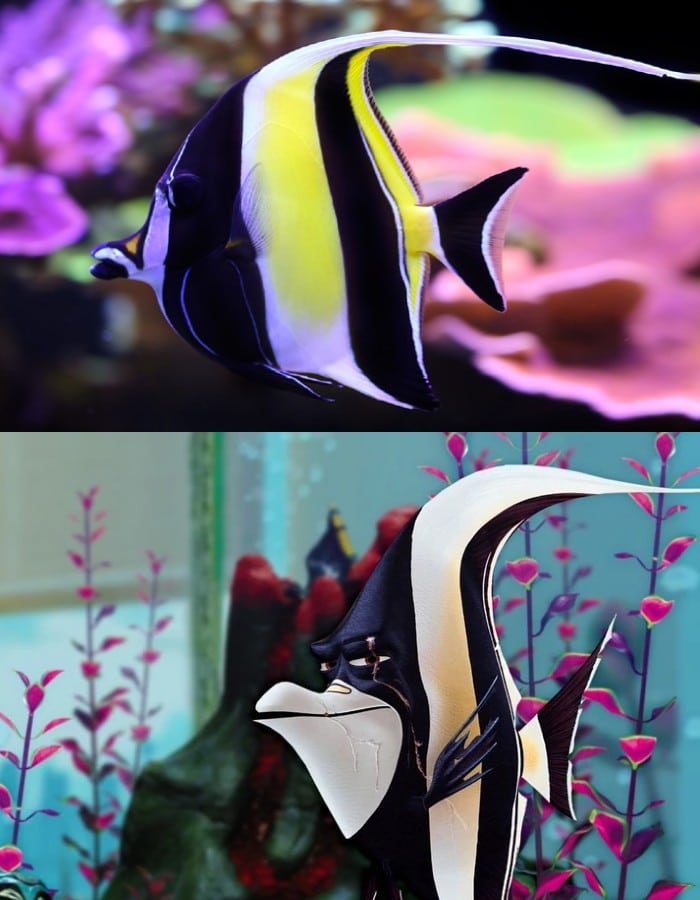
Moorish Idol by reddo-tan
Gill, the fish with the scar on its face, that’s also found in the dentist’s office scene, is a Moorish Idol.
This fish species has a black and white body with yellow stains here and there.
In real life, the Moorish Idol doesn’t survive easily in captivity, which is why it isn’t popular in the saltwater aquarium hobby.
Anyway, biologists are almost convinced that the Moorish Idol is the only species of the Zanclus genus.
13. “Gurgle” – Royal Gramma Basslet (Gramma loreto)
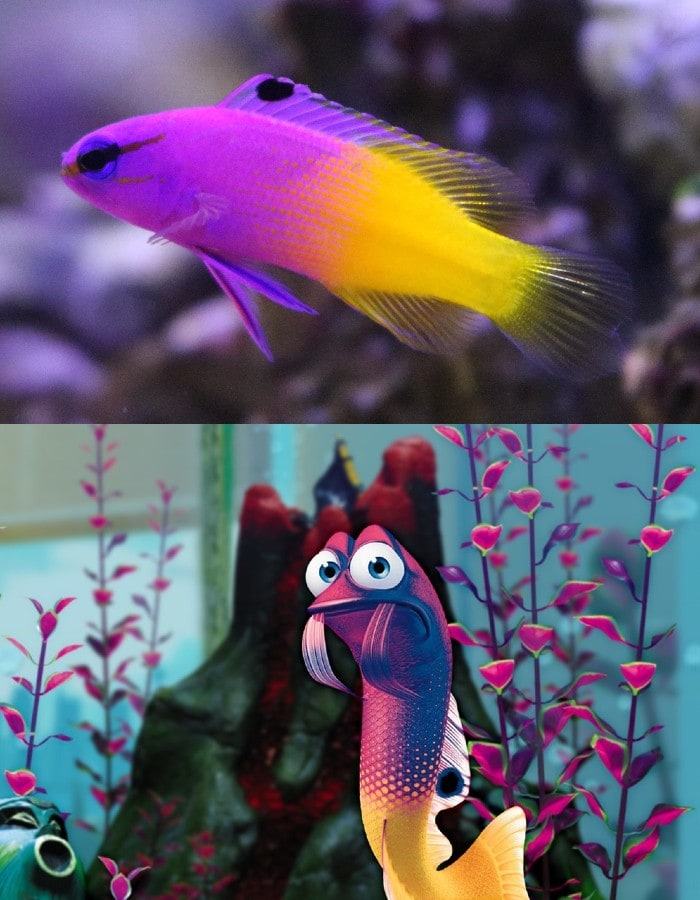
Royal Gramma Basslet by LordMarvolo
Gurgle is the beautiful half-yellow and half-purple fish in the dentist’s aquarium that wants to keep everything clean and sanitized.
In the real world, he is a Royal Gramma Basslet.
This fish comes from the Gramma genus of fishes native to the tropical waters of the western Atlantic Ocean and the Caribbean Sea.
Furthermore, It is known that all of the genus members are brightly colored, and, typically, with two different colors.
This type of fish is common for the saltwater aquarium hobby, as Royal Grammas are small, generally peaceful, and don’t require large fish tanks. If you want to learn more about these fish, you can check out my post on the best saltwater aquarium species for beginners.
14. “Bloat” – Porcupine Pufferfish (Diodon holocanthus)
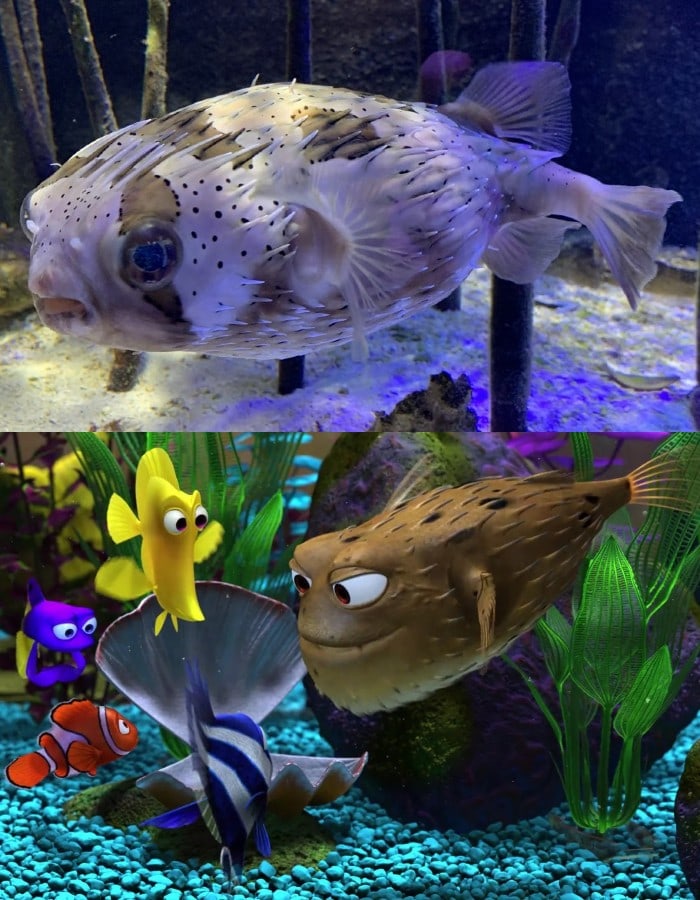
Porcupine Pufferfish by Justin_Reef
The species name of Bloat, the fish that bloats up when stressed, is Porcupine Pufferfish.
This species is one of several within the genus Diodon, belonging to the family Diodontidae.
These types of pufferfish require a big aquarium, but it’s rather simple to take care of them.
If you want to set up a “Finding Nemo”-inspired fish tank, you should consider getting a Porcupine Puffer.
They have a ton of personality and are quite fun to observe!
15. “Chuckles” – Goldfish (Carassius auratus)

Goldfish by rajan311
Chuckles is the goldfish in the bag that appeared in the picture of the girl Darla – the dentist’s daughter in the film.
The Goldfish is the most well-known species of the Carassius genus in the ray-finned fish family of Cyprinidae.
They inhabit all of the Eurasian region and the species from the Carassius genus apparently are distant relatives of the typical carps of Cyprinus.
16. The fish with the light bulb – Female Anglerfish (Lophiiformes)
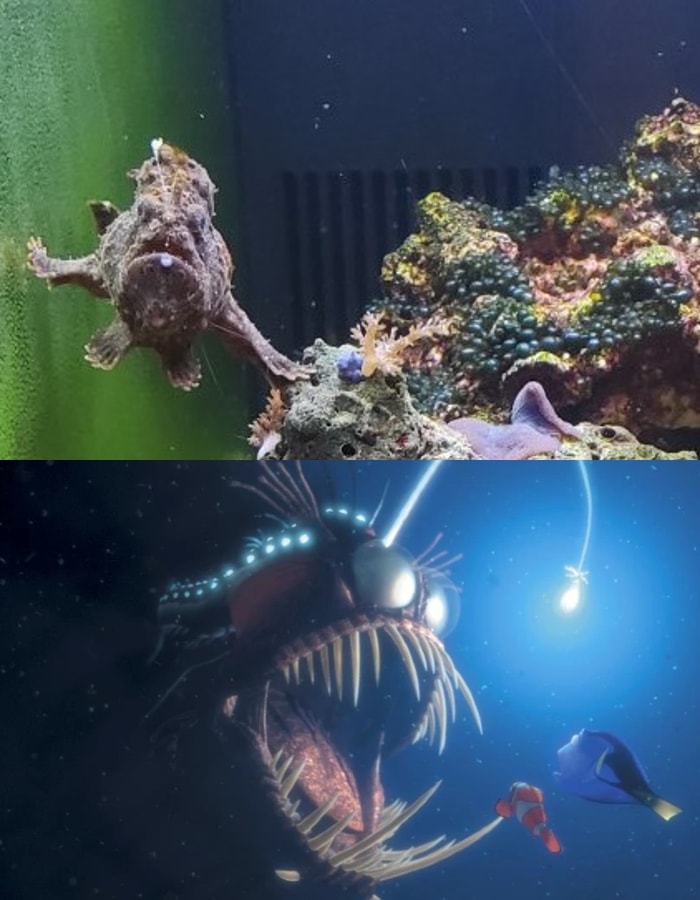
Female Anglerfish by 6lilfishies
The eerie fish with a light bulb hanging from its forehead, that also almost killed Marlin and Dory, is a female Anglerfish.
I specify that it’s a female, as male specimens don’t have a luminous lure that baits prey close enough to be eaten.
Most of the species of anglerfish live in the dark deep waters of the Atlantic and Antarctic oceans.
The anglerfish belong to the teleost order Lophiiformes.
17. “Unnamed Whale” – Big Blue Whale (Balaenoptera musculus)
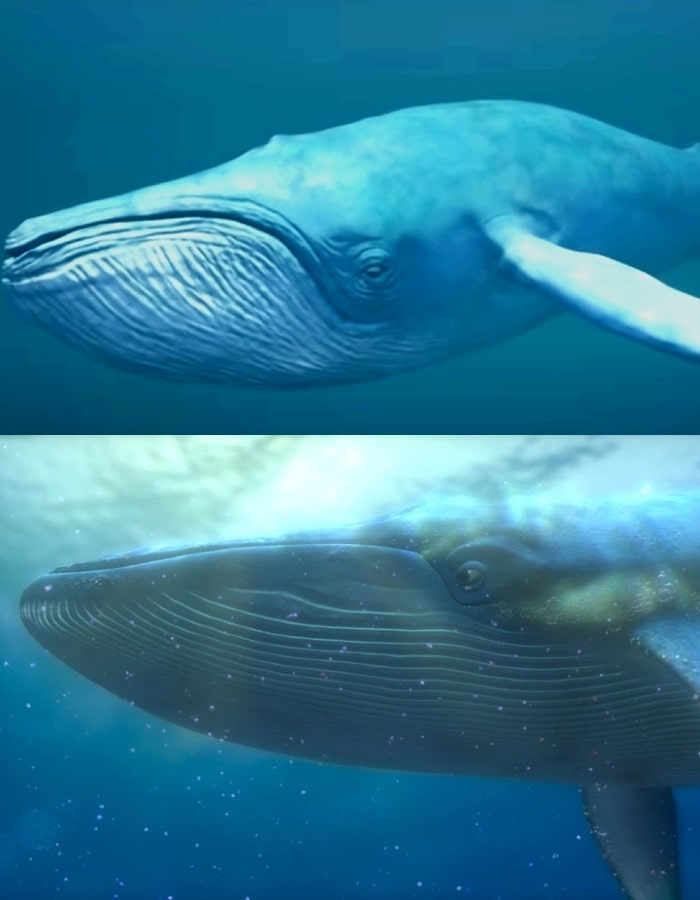
Big Blue Whale by Jasper Cousins
The Big Blue Whale from Finding Nemo isn’t actually a fish but a mammal.
The Big Blue Whale comes from the Balaenoptera genus which is essentially the largest group of baleen whales, also known as “rorquals”.
The distribution of this genus is worldwide, and Blue Whales are seen in all major oceans.
Anyway, in the film, the mysterious creature appeared out of nowhere and almost swallowed Marlin and Dory when they were on their way to save Nemo.
A fun fact about this marine mammal is that it has no teeth.
Instead, it has hundreds of baleen plates that look like the bristles of a comb.
The plates serve as a filter of sorts.
The whale first opens its mouth to take in water and then pushes the water out through its bristles.
The baleen plates filter the aquatic creatures, leaving them inside the mouth of the Big Blue Whale.
There, they remain as their source of food.
18. “Crush”, “Squirt” – Green Sea Turtle (Chelonia mydas)

Green Sea Turtle by wilturtlelover
So these are technically not fish but turtles.
Crush, Squirt and the other turtles that Nemo and Dory venture with through the East Australian Current are all Green Sea Turtles, also known as Pacific Green Turtles.
In real life baby sea turtles do use ocean currents to help them travel from one place to another.
Green Sea Turtles are members of the family Cheloniidae but are somewhat unique compared to their cousins.
These turtles are primarily herbivorous, unlike most other sea turtles.
19. The fish that form shapes when Marlin asks them about Nemo – Pacific Moonfish (Selene peruviana)
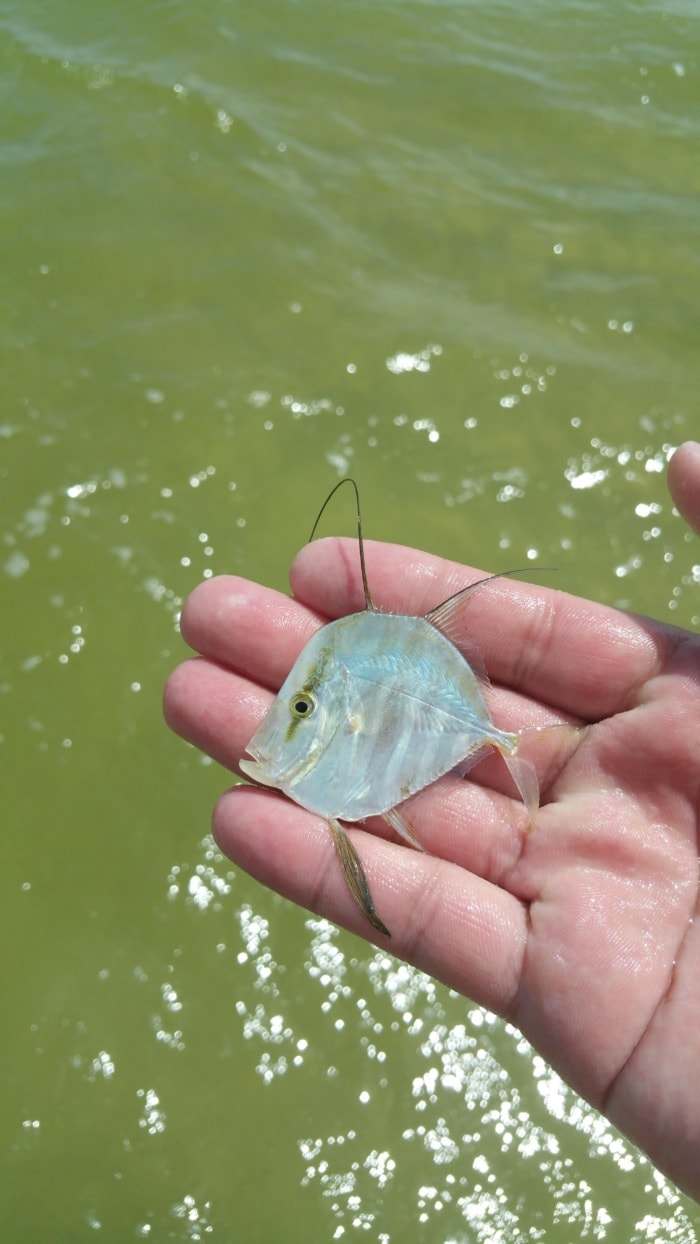
Pacific Moonfish by Constantine1988
The group of fish that openly dislike Marlin and mock him through forming various shapes are called Pacific Moonfish.
They come from the genus Selene and are also known as Peruvian Moonfish.
In the wild, these fish really swim in tight groups which is a defensive mechanism to confuse predators.
A group of fish is called “a school”.
20. “Blenny” – Blenny (Blenniidae family)

Blenny by oppe1
At one point in the movie, Marlin and Dory are forced to participate in the sharks’ meeting.
During their meeting, the frightening sharks had to bring a fish friend as evidence of their progress.
Anchor, the hammerhead shark, introduced Blenny to the group – a stressed-out green fish with dark spots and big lips.
Blenny is a minor character in Finding Nemo and he’s a type of fish from the suborder Blennioidei, commonly known as blennies.
Unlike sharks, blennies are a popular choice for home reef aquariums.
21. “Jacques” – Pacific Cleaner Shrimp (Lysmata amboinensis)
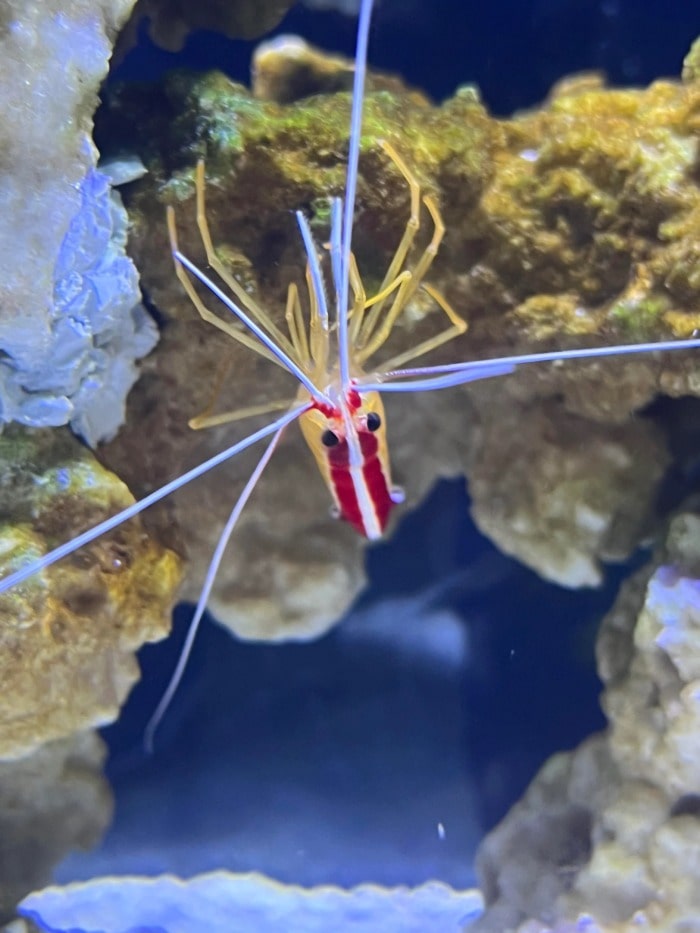
Pacific Cleaner Shrimp by fluvalevo13
Jacques from the dentist aquarium is a Pacific Cleaner Shrimp or as it’s known in the scientific community – Lysmata amboinensis.
Jacques is the character that cleans Nemo after the cute clownfish says he’s coming from the ocean.
In real life, Pacific Cleaner Shrimp are part of a group of animals, appropriately named the Clean Up Crew of the ocean.
They feed on small algae and other microorganisms, effectively “cleaning” corals, rocks and even live fish.
22. “Peach” – Sea Starfish (Asteroidea)

Starfish by MrUnfuxxwittable
The pink star-shaped creature Peach from the dentist’s tank is what is known as a Startfish or a Sea Star.
Although they have “fish” in their name, starfish are actually an invertebrate.
This means they lack a backbone, same as snails and jellyfish, for example.
Although they may seem defenseless, starfish are a scavengers and mainly feed on other slow animals in real life.
23. “Sheldon”, “Bob” – Seahorse (Hippocampus)

Seahorse by oceanpup01
While Nemo is still in the Marine Life Institute he meets Sheldon, who is a seahorse, same as his dad Bob.
There are 46 species of real life seahorses, all within the genus Hippocampus.
The word hippocampus literally means “horse sea monster / horse sea animal”.
One really interesting fact about seahorses is that their biology makes it possible for the males to carry the babies.
24. “Kathy” – Triggerfish (Balistidae family)
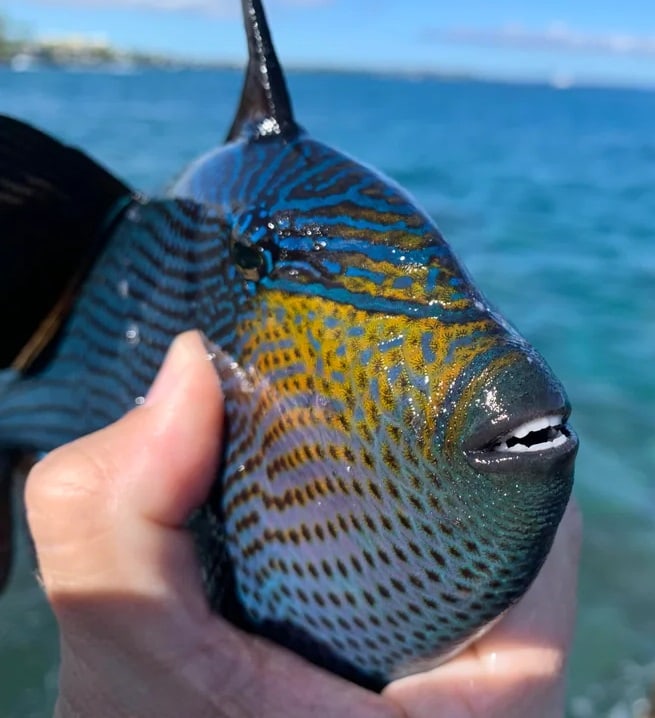
Triggerfish by SPF_Infinity
Nemo’s classmate Kathy is the fish with buck teeth. Kathy is a kind of Triggerfish from the family Balistidae.
Triggerfish are look quite exotic and are sometimes kept in home aquariums.
They are aggressive and need A LOT of swimming space, which means that only expert level aquarists should try to keep them at home.
Final Words
I hope I helped you with understanding what the real fish species from Finding Nemo are.
Other minor characters that I didn’t include in the list are the school of fish that get cought in a fishing net alongside Nemo. These fish are, in fact, Tuna fish.
Anyway, if there are any other questions that I can answer regarding the topic, please leave me a comment below.


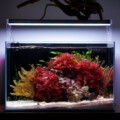

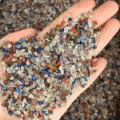

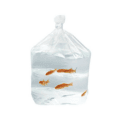
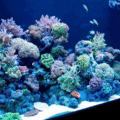
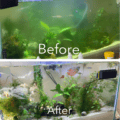
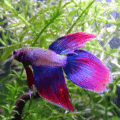
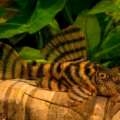
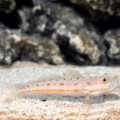
Which of the 17 types of fish are easy to care for?
Hi,
Clownfish are a staple for beginners in the saltwater aquarium hobby. They are hardy and full of personality.
Momchil